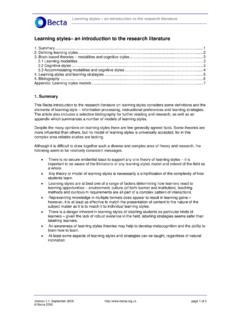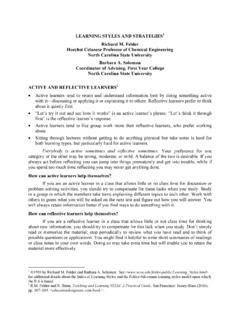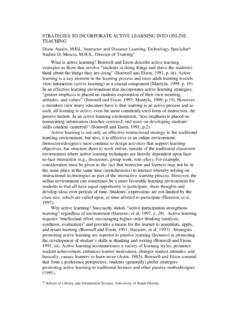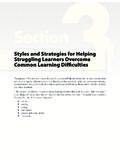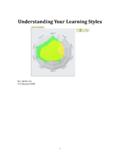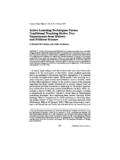Transcription of quick guide effectivepractice - Learning for Teaching
1 effective practiceLearning styles and their application for effective learningBy Ian Duckett and Marilyn TatarkowskiThe aim of this leaflet is to provide up-to-date knowledge concerning Learning styles and some strategiesto promote effective Learning and Teaching by exploring: effective practiceIncreased Flexibility Support Programmequick guidelIt can inform Teaching and learninglUse of this data will lead to clear Learning plans forindividuals and/or groupslThis information can be linked to targets with goalsand objectiveslStudents individual needs can be metlIt can empower students to be more effective and inde-pendent learners lStudents can work using their strengths but alsostrengthen their weakest areaslIt can be used for differentiation in Learning lWhy we are focusing on Learning styles ?lWhat is meant by visual, auditory and kinaesthetic Learning styles ?
2 LA practical understanding and application ofpreferred Learning styleslAn analysis of Learning styleslThe development of Learning styles for use by practitioners and learners in the learningenvironmentWhy are we focusing on Learning styles ?There can be a discrepancy between the way the brain learns and the way students are taught. Students will learn contentbetter through their preferred Learning style. We know that teachers tend to teach in their own preferred Learning style. The reasons why we should find out students preferred Learning styles are: What is meant by a Learning style?A Learning style is the way in which an individual learner tries to learn. It includes how they approach Learning , experiencelearning and utilise information. Filling in questionnaires and quizzes to determine preferred Learning styles can be funbut will not be effective unless they become part of an ongoing programme of Learning how to learn for students.
3 Howyou present something is often as important as what you say - indeed it may determine whether it is understood at is meant by a Learning style? shows that approximately a third of the popula-tion has a preferred Learning style which is visual, a thirdthat is auditory and a third that is kinaesthetic. It is pos-sible that each preferred Learning style could be genetic,dependent on which part of the brain is most receptive ineach of the three areas, or because of the way that wewere taught. Some students have a preferred Learning style that is: lVisual - they learn mainly through seeinglAuditory - they learn mainly through hearing;lKinaesthetic - they learn through doing Some students will have a combination of two or some-times all three of the Learning styles . The visual, auditoryand kinaesthetic Learning styles are the ones associatedwith accelerated Learning and are widely used throughoutprimary and secondary schools.
4 Students Learning styles can change and develop and donot necessarily stay the same. A practical understanding & application of Learning stylesBy finding out a student s preferred Learning style you willbe able to identify possible challenges for a student ontheir particular course or courses. Evidence suggests thatstudents attracted to vocational courses are more likelyto have a kinaesthetic preferred Learning style. Many stu-dents enjoy the practical element of a vocational coursebut find the theory part of the course quite can be when inappropriate behaviour can of the reasons for this is that theory tends to betaught in a visual and auditory way and therefore thekinaesthetic learner finds it even more of a challengethan the other learners. There is a simple activity on the LSDA website that canbe used with both staff and students to illustrate thateach of us notices different aspects of the same analysis of preferred Learning styles There are many quizzes and questionnaires to helpanalyse VAK Learning styles .
5 If you use a diagnostic proce-dure to find out preferred Learning styles then thereshould be some kind of spread of Learning styles . Forexample if all students are coming out as equally efficientin all three styles then there is something wrong with thetest. In the same way, a survey on the height of studentswhich suggests that everyone is the same height - is notpossible. Try the common sense way of diagnosing pre-ferred Learning styles on the next page below - it is a bitof fun but also illustrates the point of them. A common sense way of diagnosing preferred Learning test - one good way to find out your preferredlearning style is to do the Ikea or MFI test or anythingthat you buy that you have to If you buysomething that you have to assemble when you get ithome, do you:1. open the packaging and try to put the item or furnituretogether without reading the instructions?
6 All of the instructions before you attempt to putthe item together?3. hand the instructions to someone else to read them toyou, or read them aloud to yourself? B. Mobile phone test similarly with a new mobile phonedo you: it out of the box and fiddle with the pieces beforeyou read any instructions?2. read all of the instructions before you attempt to pressany buttons? someone else to read the instructions and explainit to you or read the instructions out to yourself aloud? reading - Many people use a map and possiblywrite down some instructions when finding their way toa new location. Do you: 1. look at a map & follow all of the roads with your finger? at the whole map and then look at every road?3. read out every road to yourself? Please circle the relevant answer belowA1 = K A2 = V A3 = AB1 = K B2 = V B3 = AC1 = K C2 = V C3 = AConclusion =For further examples of Learning styles assessmentsplease go to that diagnostic assessment of quizzes andquestionnaires are only guides to Learning styles .
7 Youmay know that a student has a preferred Learning style bytheir behaviour. For example people who are: lVisual learners usually enjoy reading books and mayappear to day-dream during a session with a lot of verbal activitieslAuditory learners usually like discussion in lessons andmay tend to whisper when readinglKinaesthetic learners usually tend to remember thingsthat they do and experience and may tend to tap theirpencil or pen during a lessonFor more information on Learning styles contact the IFSPin house development administrator Helen Asemota The Development of Learning styles for use by practitioners and learners in the Learning environmentNow that you have looked at the visual, auditory andkinaesthetic Learning styles , the next step is to look atyour schemes of work and lesson plans. Do the schemesof work include visual, auditory and kinaesthetic strate-gies in each lesson?
8 You can work through theseschemes and colour code the VAK strategies that areincluded. For example, visual can be highlighted in blue,auditory in green and kinaesthetic in you undertake this exercise as a whole departmentactivity and pool resources then lesson preparation willbe used more deploying Teaching styles that include all three learningstyles in your lesson you can ensure differentiation isembedded in every lesson and then students individuallearning needs will be met. Preferred Learning styles can also be included in an indi-vidual or student action plan. The action plans can helpstudents work using their strengths and help with theirchallenges. Very specific achievable goals and targetscan be included in the action plan. Look at some of thestrategies below that can be used to help studentsbecome independent learners. How to enhance the visual approach of Learning lUse lots of post-its, posters, cue cards, diagrams andchartslPlace information, key words and posters, above eye-level in the roomlUse coloured pens and paperlTracinglUse mind maps and spider diagramsHow to structure a variety of oral inputlEngage in class discussionlUse poems, rhyme, rhythm, rap and jingleslRead passages or questions out loudlHave background music on while studyinglLearners revise best when they are asked questionswhen studying for a test or examHow to aid kinaesthetic Learning lBuild in regular planned physical breaks (20 minutes)
9 LUse brain gymlGet involved in group work, role-play and gameslUse card or post-its to make key points, reviewing sessions etc and manoeuvre it about until the contentmakes senselModel makingFinally, remember the key to meeting individual students needs is to ensure a variety of Learning styles in informationfurther informationThere are many potential sources of information on Learning styles . Contacting the LSDA and keeping a check on thewebsites below is likely to prove a useful starting point:LSDAR egent Arcade House19-25 Argyll StreetLondon W1F 7LS020 7297 key contactsMark Ellis, Programme Leader Duckett, Development Gormley, Development Beamish, Development Lane, Development Rowe, Development general informationNick Bloom, Senior Information Officer020 7297 , T (1993) The Mind Map Book: Radiant Thinking London: LongmanHughes, M (1999) Closing the Learning GapStafford: Network Educational Press Robinson, Ken (2001) Out of our Minds: Learning to be CreativeOxford: CapstoneSmith, Alistair (1999) Accelerated Learning in PracticeStafford: Network Educational Press






